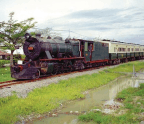
From Sudan Notes and Records Vol. 20, No. 1 (1937), pp. 107-124.
The building of this extraordinary fragment of a railway and its abandonment in the face of the enemy after only twenty miles of track had been laid was one of the minor incidents of the Anglo-Egyptian campaign against the Mahdi. Yet this incident cost the British Treasury close on a million pounds. Its merits and its folly were fiercely debated in Parliament and it was one of the principal causes which brought Mr. Gladstone’s Second Administration to its fall.
The project of a railway connecting Suakin with some point on the Nile was not new in 1885. A succession of travellers over the route had recommended it. The project had already been considered by the Egyptian Government and rejected in favour of a Nile valley railway several years before the outbreak of the rebellion in the Sudan. Egyptian railway policy under the Khedive Ismail was influenced by the fact that the Suez Canal was not in Egyptian hands. Political events, however, caused a change in railway policy and in 1883 a commission of the Egyptian Government, after considering the alternative route, supported the Suakin-Berber plan.
The Mahdi revolt gave impetus to the projected railway. The British Government, probably influenced by the publication of Col. D. Stewart’s Report on the Sudan in which a narrow gauge line was suggested, began to take an interest in it. Lord Dufferin, then on a special mission to Egypt, recommended that the railway should be carried westward over the Red Sea hills and the Atbara river direct to Shendi. Sir Samuel Baker, who already had experience of building railways in the Balkans, held that the line should meet the Nile upstream of the Sabaloka cataract whence navigable water prolongs the route into the heart of Equatoria.
By the beginning of 1884 the revolt had grown too serious for academical discussions of railway routes. Gordon was shut up in Khartoum and the Egyptian administration throughout the country was losing its grip. While the British Government were making up their minds on the question of intervention in the Sudan, the War Office was studying the possibility of using railway construction as a means of relieving the beleaguered garrisons. As early as the 10th February Sir A. Clarke, Inspector-General of Fortifications, submitted to the War Office a paper advocating the construction of a railway from Suakin to Berber. On the 19th May he prepared an estimate for Lord Hartington, Secretary of State for War, of the cost of the line which he placed at £1,250,000, a figure which included the erection of defensible stations along the route.
The War Office, still undecided, resorted in its uncertainty to an expedient recalling a well-known parlour game. Lord Wolseley, then Officer Commanding in Egypt, and three other knowledgeable officers, were ordered to write separate memoranda on the advantages and disadvantages of a Suakin-Berber railway in a possible campaign for the relief of the garrisons in the Sudan. The memoranda were then compared. In spite of differences on other issues, all four favoured a railway of narrow gauge.
On the 14th June the Secretary of State informed General Sir F. Stephenson, Wolseley’s successor in Egypt, that the Government had decided to take some preliminary steps to facilitate the construction of the railway. The 17th Coy., Royal Engineers, was sent to Suakin to build jetties and prepare the port as a railway depot. The detachment contained men experienced in railway survey and construction. A local light railway of 18-inch gauge was laid round the town. A. B. Wylde, a civilian living at Suakin at the time, ridiculed this petty undertaking. He noticed that the Sappers were building their jetties of white, untreated wood and would be lucky if they lasted eighteen months. The jetties were too small, too trashy, thought Wylde, for serious work. The end of August found the British Government still unable to come to a decision to build the railway and the preliminary work at Suakin was stopped for the while.






